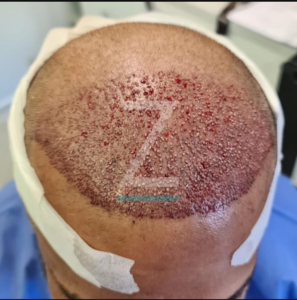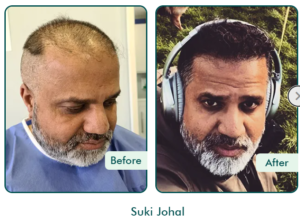Hair loss is a widespread issue that affects millions of people throughout the world. Whether due to genetics, ageing, or other factors, losing hair can significantly impact one’s confidence and appearance. Thankfully, advancements in hair restoration techniques have made it possible to regain lost hair through procedures like Follicular Unit Extraction (FUE) and Follicular Unit Transplantation (FUT). This article details both methods, helping you understand the differences between FUE and FUT and how to choose the right option for your needs.
What is a FUE Hair Transplant
A fue hair transplant London involves extracting individual hair follicles directly from the scalp’s donor area, typically the back of the head, where hair is thicker. These follicles are then implanted into areas experiencing hair loss. This method focuses on precision, ensuring each follicle is carefully removed and placed for natural-looking results.
Procedure Details
During an FUE procedure, a surgeon uses a micro-punch tool to extract hair follicles one by one. This meticulous process minimises damage to surrounding tissue, making it ideal for patients seeking minimal scarring. The process may take several hours, depending on the quantity of grafts necessary.
Benefits of FUE
- Minimal Scarring: One of the biggest advantages of an FUE hair transplant is the lack of visible scarring. Since follicles are extracted individually, any scarring that does occur is minimal and dispersed, allowing patients to wear shorter hairstyles without concern.
- Quick Healing: The recovery time after FUE is generally faster than other methods, with most patients resuming normal activities within a few days.
- Suitable for a Range of Hair Types: FUE is an excellent option for those with tight scalps or those who prefer short hairstyles, as it doesn’t leave a linear scar.
Limitations of FUE
- Longer Procedure Time: Because of the precision involved in extracting each follicle, FUE can take longer than FUT.
- Higher Cost: FUE tends to be more expensive due to the time and skill required to perform the procedure.

What is FUT Hair Transplant
Follicular Unit Transplantation (FUT) is a more traditional approach where a strip of skin containing hair follicles is removed from the donor area. The strip is then dissected into individual grafts, which are implanted into the recipient area.
Procedure Details
In a FUT procedure, a surgeon removes a strip of skin from the donor site, usually from the back of the head. This strip is then divided into smaller grafts under a microscope, which are carefully implanted into the areas of thinning hair. The wound is stitched, leaving a linear scar at the donor site.
Benefits of FUT
- More Grafts in a Single Session: FUT allows for a larger number of hair grafts to be transplanted in one session, making it ideal for patients with more extensive hair loss.
- Cost-Effective: Compared to a FUE hair transplant, the FUT method is generally less expensive, making it accessible to a wider range of patients.
Limitations of FUT
- Linear Scar: The strip removal method leaves a linear scar on the donor area, which can be visible if the hair is kept short.
- Longer Recovery Time: Recovery after FUT can take longer, as the linear incision needs time to heal. Patients may also experience more post-operative discomfort.
Comparing FUE vs. FUT: Which is Right for You
-
Scarring and Recovery
When comparing FUT vs. FUE, scarring is one of the most significant differences. FUE results in tiny dot-like scars that are less noticeable, whereas FUT leaves a linear scar that may be visible with shorter haircuts. If minimal scarring and a quick return to everyday activities are priorities, FUE might be the better option. However, if covering a larger area of hair loss in fewer sessions is more important, FUT could be the way to go.
-
Cost Comparison
The cost of hair transplant procedures varies based on factors like the clinic, the surgeon’s expertise, and the number of grafts required. Typically, FUE is more expensive than FUT due to the labour-intensive nature of the process. However, some patients view FUE as a worthwhile investment for its minimal scarring and faster recovery.
-
Suitability for Different Patients
Choosing between a fue hair transplant and FUT largely depends on individual needs. Patients with mild to moderate hair loss and those who prefer short haircuts may benefit more from FUE. On the other hand, those with significant hair loss who want to maximise the number of grafts in a single session might find FUT more suitable.
This table highlights the key differences between FUE and FUT hair transplants, making it easy to compare the two options.
| Criteria | FUE | FUT |
| Scarring and Recovery | Tiny dot-like scars that are less noticeable; quicker return to everyday activities. | Leaves a linear scar that may be visible with short haircuts; and longer recovery time. |
| Cost Comparison | Generally more expensive due to the labour-intensive process; valued for minimal scarring. | Less expensive; and suitable for those who want more grafts in fewer sessions. |
| Suitability for Different Patients | Ideal for those with mild to moderate hair loss, especially if preferring short haircuts. | Better for those with significant hair loss needing a larger number of grafts in one session. |

Side Effects and Risks of FUE and FUT Hair Transplants
Both FUE and FUT are generally safe procedures for hair restoration, but they do carry some potential side effects. Understanding these risks can help patients make more informed decisions and ensure a smooth recovery.
Common Side Effects for FUE and FUT
- Swelling: Post-surgery swelling is common around the forehead and eyes, often peaking around the third day. This can be managed with cold compresses and anti-inflammatory medications.
- Minor Bleeding: Small amounts of bleeding may occur from the donor and recipient areas, typically subsiding within a few days. Gentle cleaning and following the post-operative care instructions provided by the surgeon are crucial to manage this.
- Discomfort and Pain: Mild discomfort and tightness in the treated areas are typical, especially in the first few days. Manage the pain with the prescribed painkillers by your surgeon.
- Numbness or Itching: Temporary numbness or itching in the scalp is a common reaction as nerve endings heal. It is important to avoid scratching the area to prevent any damage to the newly transplanted follicles.
FUE-specific Risks
- Follicular Transection: During an FUE hair transplant, there is a risk of transecting or damaging nearby hair follicles with the micro-punch tool. Although skilled surgeons aim to minimise this, it can affect the overall yield and density of the transplant.
- Overharvesting: There is a risk of overharvesting hair from the donor site, which can lead to a noticeable thinning in the area. Ensuring a balanced extraction pattern is critical for maintaining a natural appearance.
FUT-specific Risks
- Linear Scar Formation: The removal of a strip of skin during FUT leaves a linear scar, which can sometimes widen or stretch over time. While this scar is typically hidden by longer hair, those who prefer shorter hairstyles may find it more noticeable.
- Tightness in the Donor Area: As the linear incision heals, some patients experience a feeling of tightness in the scalp where the strip was removed. This sensation usually diminishes over time, but it may take several weeks to months.
Importance of Choosing a Reputable Surgeon
Selecting a qualified and experienced surgeon plays a crucial role in minimising the risks associated with both fut vs fue. A reputable surgeon will:
- Properly Assess Hair Loss: They will evaluate the extent of hair loss and recommend the most suitable technique based on your needs.
- Use Advanced Techniques: Skilled surgeons utilise the latest tools and methods, ensuring precise extraction and placement, which reduces trauma to the scalp and promotes faster healing.
- Provide Detailed Aftercare Instructions: Proper aftercare is vital for successful healing. Surgeons will provide tailored post-operative guidance to prevent complications like infection and ensure the best possible outcome.
With careful planning and the right expertise, the risks associated with hair transplant procedures can be minimised, leading to a successful and satisfying restoration of your hair.
Final Thoughts
Deciding between a fue hair transplant and FUT depends on your hair restoration goals, budget, and lifestyle. While FUE offers minimal scarring and quicker recovery, FUT can provide more grafts in a single session at a lower cost. Both methods are effective, but it’s essential to consult with a qualified hair transplant specialist to determine the best approach for your needs.
For those seeking professional consultation and personalised care, Zestige Private Healthcare offers expert guidance and tailored solutions for all hair restoration needs.



